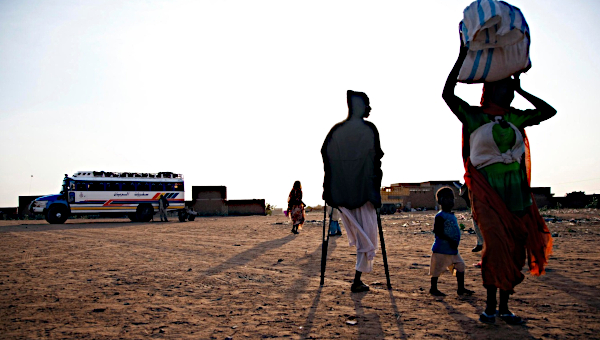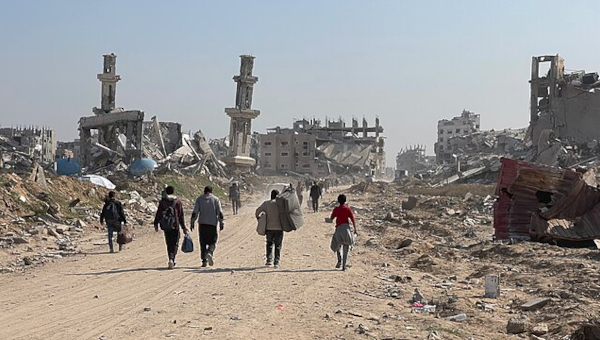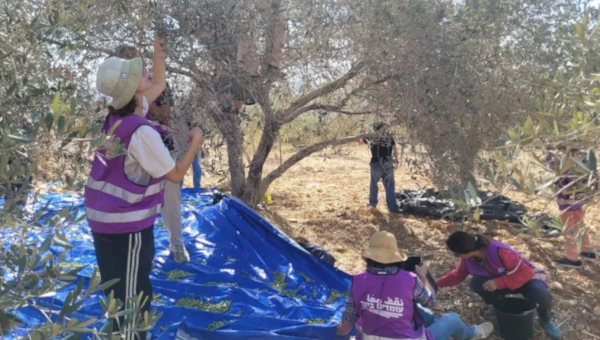Why Canadian Forces Should Immediately Withdraw From Afghanistan
On 18 October 2007, two thousand delegates at the national convention of the Canadian Union of Public Employees (CUPE) decided in a nearly unanimous vote to demand the Government of Canada immediately withdraw the Canadian Forces from Afghanistan. CUPE is the largest union in Canada representing half a million Canadian workers.
Later on the same day, CBC, the Globe and Mail, and La Presse released the results of a jointly-commissioned poll conducted in Afghanistan by the Canadian research firm Environics. The Environics
poll indicates a large majority of Afghans want the Canadian Forces to remain in Afghanistan.
Are the CUPE workers out of step with what most Afghans really want? I don’t think they are, based on my own experience listening to what some Afghan workers and intellectuals have to say about our occupation of their country. Instead, I am sceptical of the results of the Environics poll.
I spent five weeks in June and July of 2007 travelling throughout Afghanistan with my research partner from the Afghanistan Canada Research Group (ACRG) Hamayon Rastgar. Hamayon was born in Afghanistan and is now a Canadian citizen studying at York University.
Based out of Kabul, I travelled with Hamayon to Bamiyan and Yawkawlang in the central region of Afghanistan, north into Parwan province, and as far south as the city of Ghazni. During Hamayon’s three month visit, he travelled further north to Mazar-e-Sharif and Konduz and as far south as Kandahar City.
The purpose of our visit was to ask ordinary Afghans – particularly workers and students who do not have a voice in either the international or Afghan media – what they think about the international military intervention in their homeland.
We set up a video camera on two university campuses in Kabul and Bamiyan, at the teachers’ college in Kabul, on street corners and in markets, and on one occasion even on a mountain top. We invited Afghans to tell us on camera what they think of the international military intervention. Before our camera unfortunately broke down, we recorded thirteen hours of footage.
I can make no claim that our own research in Afghanistan is scientifically conclusive; it was in fact anecdotal and relied on the self-selection of respondents who volunteered to appear on camera. However, the fact that most people responded negatively to our question regarding their opinion of the international intervention suggests the possibility of a large degree of error in the Environics poll. Our observations of the international development project, or more accurately the lack of implementation of a systemic project for the benefit of most Afghans, also suggest a large degree of error in the Environics poll.
I wonder about the methodology of the Environics poll. How did the pollsters select who to interview? Was it possible for the interview subjects to feel safe enough to criticise the theocratic military regime under which they are ruled? These and many other questions regarding the methodology of the Environics poll remain unanswered.
The Environics poll was commissioned by the CBC; La Presse; the Globe and Mail; the Munk Centre for International Studies; and the Centre for European, Russian, and Eurasian Studies (CERES). The poll was contracted to
Environics, which in turn subcontracted data collection to the Afghan Center for Social and Opinion Research (ACSOR) in Kabul, which is a subsidiary of the
American company, D3 Systems Inc. (at www.d3systems.com).
The quantitative analysis of the Environics poll fails to capture the kinds of complexly nuanced responses we heard from Afghans.
Considering the degree of forceful repression that still exists in Afghanistan, and therefore the very real possibility of retribution directed against anyone critical of the theocratic state regime, the negative responses regarding the international intervention we heard are quite remarkable. Based on what many brave Afghans told us, as well as our own observations of the social environment in the provinces we visited, I am very sceptical of the overwhelmingly positive responses to the questions asked in the Environics poll.
Many Afghans told us they are tired of suffering the painful consequences of imperial wars fought in Afghanistan – first the British versus the Russian in the 19th and early 20th centuries, then the Americans versus the Soviets later in the 20th century and now this invasion to secure Western interests in the region. Many Afghans told us each invading force – the British, the Soviets and now the Americans – claims to represent the best interests of Afghans, but proves in the end to only serve its own self-interest at the expense of most Afghans.
How democratic is the theocratic regime of Afghanistan?
Most international reports do not recall Afghanistan, which had always been a secular state, was instituted as the Islamic Republic of Afghanistan in 1992 with the support of the United States. Afghanistan remains a theocratic state today thanks to the current international military occupation.
Afghanistan is an Islamic theocracy ruled under Sharia law and martial law imposed by the international military forces – Afghanistan is by no means a secular democracy where people enjoy even the limited rights and freedoms we experience in North America and Europe. Knowing the history of the forces that created the current theocratic military regime of Afghanistan is essential to understanding Canada’s military role.
Mujaheddin warriors, who were supported throughout the 1980s with billions of dollars of American military aid siphoned through the Pakistani secret service, finally destroyed the socialist government of Afghanistan in 1992 and declared the country an Islamic republic. A bloody civil war fought for the next four years (1992-1996) between competing Mujaheddin factions vying for power reduced 80% of Kabul to rubble, killed and maimed thousands of civilians, and forced thousands more to flee their homes.
In addition to targeting civilians, all the Mujaheddin factions are accused of numerous other war crimes and crimes against humanity including: abduction; prisoner abuse; mutilation and torture; forced labour; disappearances; rape and sexual violence; as well as pillage and looting.
In 1996, Taliban warriors defeated the Mujaheddin in Kabul forcing the retreat of various factions to the north and the east of the country. After defeating the American-supported Mujaheddin, the Taliban imposed an even more repressive regime of Sharia law on the Afghans who lived within the Taliban sphere of control.
Two of the most powerful Mujaheddin factions united to form what we know as the Northern Alliance to hold control of northern Afghanistan. In 1998, the United States brokered a treaty between the Taliban and the Northern Alliance in hopes of stabilising Afghanistan to serve American geostrategic and economic interests including a trans-Afghanistan pipeline.
After the attacks of 9/11, the United States used the Northern Alliance as their ground forces to overthrow the Taliban. The military leaders of the Northern Alliance – the same leaders accused of multiple war crimes and crimes against humanity and who instituted the repressive and misogynist Islamic republic of Afghanistan – now form the core of the ruling and business class of Afghanistan.
Hamid Karzai, is a member of a powerful Pashtun family from Kandahar. He was a Taliban until he fell out of favour with other Taliban leaders in the 1990s. Karzai was installed as the leader of Afghanistan at the Bonn conference in the fall of 2001 by an elite group of international leaders. Karzai represents the established ruling class of the former Afghan monarchy as well as representing a compromise between Pashtuns from the south and east and the predominantly Tajik leadership of the Northern Alliance.
Confirming Karzai’s leadership in a national election three years after his installation by the American military provides a thin façade of democracy for the theocratic regime now kept in power by the international military forces.
The CUPE delegates made their decision to demand the withdrawal of the Canadian Forces from Afghanistan with the knowledge that the theocratic government propped-up with the help of our military is a repressive and misogynistic anti-democratic regime. Many progressive secular Afghan organisations must remain underground under the current theocratic regime.
What role is Canada playing in Afghan war casualties?
The CUPE delegates also made their decision to demand the withdrawal of the Canadian Forces from Afghanistan with the knowledge that thousands of Afghans have been killed by the international forces and many more thousands injured, since the initial invasion in 2001. Many more thousands are made refugees by the counterinsurgency tactics used by the international forces that destroy the homes and livelihoods of Afghans. The international forces arbitrarily raid homes, arrest and detain Afghans on a regular basis.
No one knows for sure how many thousands of Afghans are killed, injured, abused and humiliated by the international forces – there is no publicly available official count – but most Afghans know what is happening in their country,
even if few Canadians do (see pubpages.unh.edu/~mwherold/memorial.htm for an
unofficial Afghan death toll compiled from media reports by an American professor).
The counterinsurgency strategy used in Afghanistan, which inevitably forces Canadian soldiers to commit war crimes and human rights violations, is a strategy that the people of Canada and Quebec condemned in the past when used by American and American-supported forces in places like Vietnam and Latin America.
Is the development project successful?
The CUPE delegates also made their decision to demand the withdrawal of the Canadian Forces from Afghanistan with the knowledge that development is not a priority of the international intervention. Few development projects of any consequence have been completed by the Canadian Forces or the Canadian International Development Agency (CIDA), the Canadian government agency responsible for development.
Spiralling inflation and a snail’s-pace program of social development is killing Afghans. According to CIDA, one of every four children dies before the age of five. After six years of occupation, only 29% of people in Kabul have access to safe drinking water, according to the Afghanistan Research and Evaluation Unit (AREU).
We witnessed desperate people in Kabul forced to draw their drinking water from beneath cesspools of raw sewage and in one location even from beneath a cemetery. We witnessed sewage flowing in the streets of Kabul, where it bakes in the sun, turns to dust and is picked up by the wind to blow disease-laden fecal matter about the city.
Few Afghans have access to adequate medical care. An investigation of CIDA, states:
We could not find evidence of CIDA work or CIDA funded work at Kandahar hospital that matched the information given to us by CIDA. …there were 28 children sharing 8 beds (CIDA in Kandahar. Senlis Council 2007).
We were unable to obtain a list of CIDA projects to tell us the specific location of projects in Afghanistan from either CIDA in Canada, or the Canadian embassy in Kabul.
The international forces claim they can not construct development projects without first stabilising the security situation. But we witnessed scenes of abject poverty immediately outside the walls of the American embassy, a neighbourhood which, along with most of Kabul, has been secure since 2001. Children line up throughout the day – sometimes waiting for hours – for water taps to be turned on. Some days no water flows from the taps if electricity fails to reach the water pumps.
We also witnessed the construction of a new shopping centre across the street from a bombed-out school. After six years of occupation, students still study in this shell of a school without protection from the weather.
With scenes like this anywhere one cares to look, it is hard for Afghans to accept the argument that reconstruction must wait for stability – a stability that will supposedly occur only after an unspecified amount of further counterinsurgency warfare.
Many Afghans find the rationalisation of the international forces hard to believe when many areas of Afghanistan are obviously considered stable enough to construct commercial developments that make a few people rich, but apparently not stable enough to construct social developments that could benefit everyone.
Many Afghans asked us: if the international forces are truly concerned with the welfare of the Afghan people, would they not have at least begun building essential public infrastructure by now, after six years of occupation?
But aren’t we liberating Afghan women?
The CUPE delegates also made their decision to demand the withdrawal of the Canadian Forces from Afghanistan knowing claims that the Canadian Forces are liberating Afghan women are untrue. How can women liberate themselves when they are oppressed by a theocratic government, worsening poverty, and have little access to education?
According to the 2006 Annual Report of the Afghanistan Independent Human Rights Commission:
Girls represent only 3% of students, and they are hardly allowed to continue their education beyond the fifth or sixth grade. In addition, the right to education is not granted to children coming from poor families. These children have to work or beg to feed their families, and are at risk as they can easily be the victims of sexual and other kinds of abuses in their working environment” (AIHRC 2006).
Another generation of Afghan girls has not received an education during the six years of international occupation.
The Afghanistan Research and Evaluation Unit adds:
Poverty – the necessity for children to work and the expense of going to school – is the primary factor inhibiting children from going to school, but especially for girls (Looking Beyond the School Walls, AREU 2006).
Women remain largely invisible in the public realm of Afghan society. The theocratic regime that the Government of Canada and the Canadian Forces is propping up is ensuring this situation does not change.
The few Afghan women who felt safe enough to talk to us said there have been some positive changes for Afghan women, since the defeat of the Taliban regime, but the reinstatement of the original theocratic regime, worsening poverty, and lack of access to education promises the continued oppression of women.
So why is Canada at war in Afghanistan?
Canadian soldiers are dying and killing Afghans to ensure the stability of our relationship within the United States. Afghanistan is in a vital geostrategic position between: Russia and the Central Asian states to the north; China to the east; Pakistan and India to the east and south; and Iran to the west.
Also, Canadian businesses in the military and development sectors profit from the war and many other businesses could soon benefit as well.
The “Old Silk Road” through Afghanistan has been a vital transportation link between the powerful states of the region for millennia. Today, the under-exploited natural resources and expanding markets of the region offer great growth potential for Canadian investors.
Afghanistan possesses “significant resources of copper, iron, gold, halite, talc, and mica and marble … as well as lithium, cesium, tantalum and niobium … and rich deposits of precious (emeralds, ruby, and sapphires) and semi-precious (lapis lazuli, tourmaline, aquamarine, kunzite, topaz, garnets, fluorite, and varieties of quartz) gemstones” (embassyofafghanistan.org). It is hard to imagine the Canadian mining industry – the world leader in exploration and exploitation – is not interested in exploiting Afghanistan’s resources.
Concrete geostrategic and economic reasons for war do serve the interests of some Canadians and some Afghans. But the delegates at the CUPE convention demonstrated on 18 October 2007 they are not prepared to kill, maim and humiliate Afghans and sacrifice Canadian soldiers for interests that benefit only an elite minority.
The CUPE delegates demand the immediate withdrawal of the Canadian Forces from Afghanistan in solidarity with the majority of Afghans. The CUPE delegates also express solidarity with Canadian soldiers. Canadian soldiers should not be forced to sacrifice their lives for a mission that is neither in the best interests of most Canadians, nor most Afghans. Nor should Canadian soldiers be forced to fight a counterinsurgency war in which war crimes and human rights violations are inevitable. •





